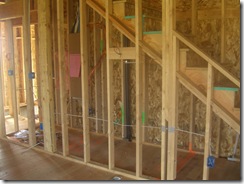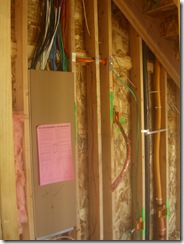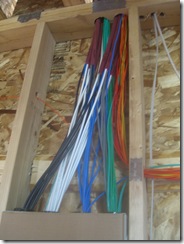Wiring the new house for a Home Network
UPDATE: Here's a Bit.ly Bundled Link of the complete "Wiring your house for Gigabit Ethernet 5 PART SERIES."
 It's official, we're moving! We close tomorrow on a house we've been building. Since it'll be not only our home but also my home office while I work at Microsoft, it needs to be wired as such. It'll be using Verizon Fiber Optic (FIOS) and my Internet connection will be 15mbps downstream and 2mbps upstream.
It's official, we're moving! We close tomorrow on a house we've been building. Since it'll be not only our home but also my home office while I work at Microsoft, it needs to be wired as such. It'll be using Verizon Fiber Optic (FIOS) and my Internet connection will be 15mbps downstream and 2mbps upstream.
The pics below are of the "framing" part of the house. For those of you who read this blog who aren't in the US, you may be surprised (or continually surprised) to see our all-wood houses. It's the one thing that we have lots of (so far) here in the US...or at least here in Oregon.
What you're looking at here is the stairs in our living room that head upstairs. The walls haven't been put on in this picture. Under the stairs is my wiring closet. The door is on the far left side there.
 The picture on the left here shows the piece of cardboard that is soon to be the wiring cabinet. It'll have a clear glass front and a lock. The wiring is all Cat 6 (not Cat 5E) and I'll be mounting a 10/100/1000 Netgear Switch in that cabinet along with a UPS and a wireless router. The switch will also let me route VOIP and RJ11 traffic over ports, so I can re-purpose ports like a small business.
The picture on the left here shows the piece of cardboard that is soon to be the wiring cabinet. It'll have a clear glass front and a lock. The wiring is all Cat 6 (not Cat 5E) and I'll be mounting a 10/100/1000 Netgear Switch in that cabinet along with a UPS and a wireless router. The switch will also let me route VOIP and RJ11 traffic over ports, so I can re-purpose ports like a small business.
There's 24 RJ45 ports, with each room having at least 2 RJ 45 and 2 Coax. The Office will have at least 10 ports. I just don't trust wireless when I can get hard-drive speed over a hard-wire. So it's Gigabit for me throughout.
Jeff Sandquist's team is going to be doing "Microsoft Cribs." He says "we're honing in on the actual technology people use in their homes." Cool. He's said I can do a video on our setup.
I figure I'll have it all setup by the end of November. Wish me luck! If this is an interesting topic, I'll do a series of posts on the wiring closet, how to save money, how to test for capacity, etc.
About Scott
Scott Hanselman is a former professor, former Chief Architect in finance, now speaker, consultant, father, diabetic, and Microsoft employee. He is a failed stand-up comic, a cornrower, and a book author.
About Newsletter
Right now when you close the wall, you can't add new cables, right?
Over here in The Netherlands/Europe we embed tubes in the concrete or bricks so we are able to pull new wires through it.
Maybe I'm missing the point but hey, I don't have experience with wooden walls.
ps: what about sound isolation? Seems to me pretty noisy.
Yeah - probably way to late at this time, but Rutger is right - if you had taken say 2" PVC pipe, and roughed that in first, as conduit, you would have been a lot better off
One thing you CAN do, if the walls are still open. Get a box of electrician's "Pull cord" - and put a run of the cord in with each cable run (better 2) and LEAVE then in there. If you ever need to pull a new cable, you use the pull cord that is already there, instead of having to fish - and you pull a NEW pull cord along with the new cable, so you always have a pull cord.
I'm slowly (VERY slowly) pulling a pair of cat-6 and 2 RG6 from each room to the basement (Used to drag cat-5e when I started the project 5 years ago)
If you do a cribs episode I'd love to see the door bell ring & you see an alert on your media center tv, with the cam on the person who is ringing the door bell, Like you described in a recent episode. Enjoy your new property.
Thx,
Catto
I like it!
Congrats on the new house. I know I am piling on with the why didn't ya...s. However I was a little surprised to see you getting a Netgear Switch. Netgear is a good consumer brand but they really don't have the chipsets to compete with the big boys such as Dell, HP, and Cisco. See through put is all dependent on how much the chipset can handle. Really what you want to look at is the switching capacity because it is totally different than bandwidth.
http://www.dell.com/content/products/productdetails.aspx/pwcnt_2324?c=us&cs=04&l=en&s=bsd
http://www.hp.com/rnd/products/switches/ProCurve_Switch_1400_Series/specs.htm
http://netgear.com/Products/Switches/SmartSwitches/GS748TP.aspx?detail=Specifications
Usually you can find very good switches on EBay for less than you can buy a consumer grade switch for. Also don't be fooled by Netgear or Linksys or even D-Link's "business grade". They don't even stack up to the low end 3 year old models that you can buy on EBay of the HP's, Cisco, and Dells.
Nick
Of course, as soon as you move in, you'll realize there is one spot you forgot to put a cable and it will annoy you forever. How do I know? :)
Also, designate where you electrical taps are and ensure your office has at least 3 dedicated circuits if you're going to have a reasonable amount of gear/UPS. I took the rule of a jack box a foot away from each power drop so that I didn't end up with wires all over the floor. For instance, I have three separate jack plates in my office alone, each with 2+ CAT5e jacks. The one by the server has 6 CAT5e jacks so that everything can have a dedicated drop to the switch to avoid overloading a single cable.
Enjoy the fun of building a house, it's a blast.
Huh?
Cost of the wire is what, 16 cents a foot? Call it 20 cents. The connectors for both ends another $2, plust the wall plate mount - say another $3 - so figure a run the length of a house is $10, + $5 for the connectors
I would also definately agree with Michael Teper - if you ever think you *might* have a computer of any type in that closet, then make your you plan for ventilation. A room that small is going to be cooking.
Another thing to consider (if it's not too late in the build process) is whole-house audio wiring. This will add tremendous Wife Acceptance Value as well as Resale Value - my wife absolutely loves ours. Even if you don't plan on installing the audio system now, you will want to at least run the wiring for it. All it requires is a Category-5 cable to be run from the anticipated locations that you would have a Volume / Channel pad (basically, next to each room's light switch). These cables should all be run to a central location - your wiring closet would be ideal. Additionally, some wiring needs to be run from each volume control pad to the speaker locations - usually a pair flush mounted into the ceiling. Dont worry - you can paint the speaker grills to match the ceiling color and your wife will never notice them. Once the wiring is in place you can opt to install the actual audio systems at your leisure. For about $5,000 you can get a decent 6-zone system that is sufficient for a 3 or 4 bedroom home... for $20,000 you can get one that totally rocks your socks off. Russound and SpeakerCraft are two affordable manufacturers to check out for this.
What's really cool is that once you have the full-house audio in place, and full-house networking, you can opt to pipe any media to any room from your Media Center hub. I love that flexibility - we have XBOX 360's that act as media terminals in various rooms, and can play music from our media center into any room as well. All with minimal visible wiring.
Got a few questions for you if you don't mind.
Did they let you run the wire yourself? Not all builders let you do that but you save tons of cash and that way you know the job is done exactly how you want it. If they ran the cable I would make sure they do a good job of terminating the cables, including the RG6. They should be using the compression type fittings on the RG6 (they are completely circular) and not the type that crimp around the cable or that screw on. They have far less loss and lower noise injection and you will notice a difference in picture quality (at least on the analog channels).
What is the large orange tube with a low voltage wall plate in this pic:
http://www.hanselman.com/blog/content/binary/WindowsLiveWriter/d25bc7249782_13F35/CIMG7379.jpg
What model of switch do you have? You said it can do RJ11 ports, which sounds like a cool feature. If you can flip a port from data to telephone without rewiring thats nifty.
I first thought I'd try the wireless approach, but after a couple of years of doing so I'm thinking that wired is a better way to go. So, I'm looking to start slowly wiring up my house.
Haha. ohhhhh how awesome that would be...
I'm not sure about scott but one big reason to pull 2 coax so that they can use satellite TV. With satellite you can't just add a splitter like with cable TV because there is actually 2-way communication between the receiver and the dish (or multi-switch) so that the receiver can tell the dish which satellite it wants to "see". If you are going to use a DVR with satellite you need two dedicated cable runs to the dish/multi-switch.
It would also be useful if you had two different RF providers, like one company for cable TV and another for cable internet, or if you were doing cable internet but satellite TV (since you get crazy amounts of HD from direct TV now)
Comments are closed.


